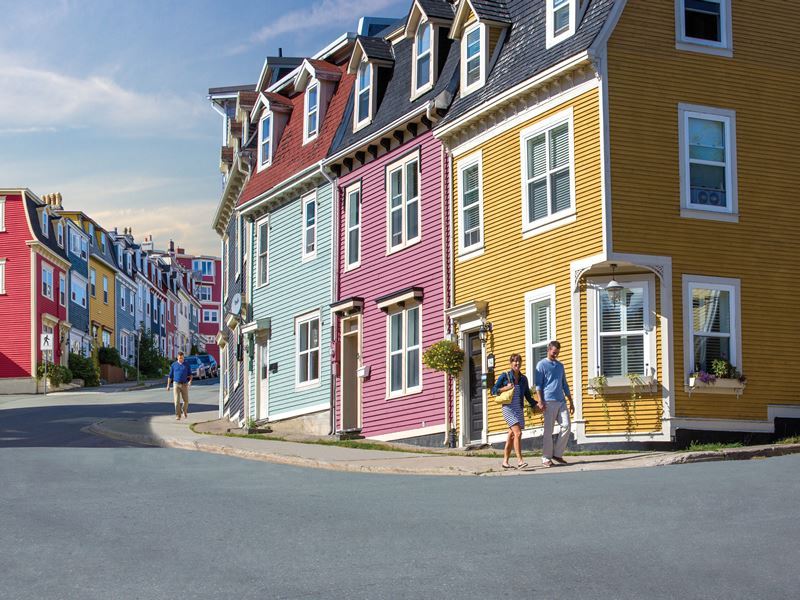Three fundamental forces mean it could endure for some time yet
NOVA SCOTIA’S largest city is known for a few things: a big national-security conference that takes place every autumn; a huge explosion that took place in 1917, causing immense devastation; and a small but impressive wine industry. It may soon be known for something else. Since December 2019 house prices in Halifax have risen by nearly 50%, according to Knight Frank, a property firm—a boom that only a tiny number of cities have bettered. Sit down with a Haligonian and before long they will express bafflement at how their city became so pricey.

Some local factors are at play. People who had moved to distant Alberta to work in the oil industry lost their jobs in 2020 and moved back home. Out-of-towners are investing in local property in the expectation that eastern Canada will become a more desirable place to live as the climate changes. Nevertheless, the broader trend is mirrored across much of the world (see chart). The IMF’s global house-price index, expressed in real terms, is well above the peak reached before the 2007-09 financial crisis. American housebuilders’ share prices are up by 44% over the past year, compared with 27% for the overall stockmarket. Estate agents from Halifax’s mom-and-pop shops to the supermodel lookalikes on Netflix’s “Selling Sunset”, in Los Angeles, have never had it so good.
Now people are wondering whether the party is about to end. Governments are winding down stimulus. People no longer have so much spare cash to splurge on property, now that foreign holidays are back and restaurants are open. Central banks, worried about surging inflation, are tightening monetary policy, including by raising interest rates. In its latest financial-stability report the IMF warned that “downside risks to house prices appear to be significant”, and that, if these were to materialise, prices in rich countries could fall by up to 14%. In New Zealand, where prices have risen by 24% in the past year, the central bank is blunter. The “level of house prices”, it says, is “unsustainable”.
But is it? Certainly there is little evidence so far that the recent tightening in fiscal and monetary policy is provoking a slowdown. In the third quarter of 2021 global house-price growth rose to an all-time high. Although New Zealand’s central bank has raised interest rates by 0.5 percentage points since October, there is only the mildest indication that house-price growth there is slowing. In 2021 the Czech National Bank repeatedly raised interest rates but prices are still moving up.
Perhaps it is just a matter of time before the house of cards collapses. But as a new paper by Gabriel Chodorow-Reich of Harvard University and colleagues explains, what might appear to be a housing bubble may in fact be the product of fundamental economic shifts. The paper shows that the monumental house-price increases in America in the early to mid-2000s were largely a consequence of factors such as urban revitalisation, growing preferences for city living and rising wage premia for educated workers in cities. By 2019 American real house prices had pretty much regained their pre-financial-crisis peak, further evidence that the mania of the mid-2000s was perhaps not quite so mad after all.
Fundamental forces may once again explain why house prices today are so high—and why they may endure. Three reasons stand out: robust household balance-sheets; people’s greater willingness to spend more on their living arrangements; and the severity of supply constraints.
Take households first. In contrast with some previous housing booms, well-off folk with stable jobs have driven the surge in prices. In America the average credit score for someone taking out a government-backed mortgage is around 750—considered pretty good by most people’s standards and far higher than before the financial crisis. In the euro area banks significantly tightened credit standards for mortgages in 2020 (though they have undone that a little since then). For many people getting a mortgage has become harder, not easier.
People are also less vulnerable to rising interest rates—and thus less likely to be foreclosed on, which often leads to fire-sales and drags down prices—than you might think. In part this is because rates are rising from a low base. In America mortgage-debt-service payments take up about 3.7% of disposable income, the lowest figure on record. But it is also because other countries are following America down the fixed-rate-mortgage path, which in the short term protects people against increases in borrowing costs. In Germany long-term fixed products are twice as popular as they were a decade ago. In Britain almost all new mortgages are fixed-rate, with five-year deals now more common. According to UK Finance, a trade body, nearly three-quarters of all mortgage borrowers will in the near term be unaffected by the Bank of England’s recent rate rise.
The third and most important reason why house prices could remain high is housing supply. The Economist’s analysis of national statistics and archival records finds that in the years before the pandemic, housebuilding in the rich world, once adjusted for population, had fallen to half its level of the mid-1960s. Housing supply has become ever more “inelastic”: increases in demand for homes have translated more into higher prices, and less into additional construction.
In many places the pandemic has dealt a further blow to supply. During the first wave of covid-19 some governments forced builders to down their tools. In the second quarter of 2020 Italian housing starts dropped by around 25%; in Britain they fell by half. Even in places where stay-at-home orders were milder and zoning laws are loose, such as Texas, the pace of extra demand was so rapid that builders could not keep up, slowed down, for instance, by the limited number of carpenters.
Shortages of materials and labour have added to the constraints. Builders are grappling with higher costs and delays for raw materials such as cement, copper, lumber and steel, and a scarcity of tradespeople is pushing wages higher. The bumper earnings and improved margins of some housebuilders suggests that many have been able to pass on the increases in costs to buyers. DR Horton, America’s largest homebuilder, said the average sales price of its homes shot up by 14% in 2021, contributing to 78% growth in earnings per share.
Some supply bottlenecks may now be easing. In October the IMF noted that global housing starts per person had begun to pick up, though they were still “considerably below the levels of the early 2000s”. But the world has a long way to go. In May 2021 researchers at Freddie Mac, a “government-sponsored enterprise” which subsidises much of American mortgage finance, estimated that the world’s largest economy faced a shortage of nearly 3.8m homes, up from 2.5m in 2018. Other estimates put the shortfall closer to 5.5m. In England an estimated 345,000 new homes per year are needed to meet demand, but builders are further away from the target than they have ever been. Unless something profound changes, pricey property may be around for a while yet.
Economist Jan 4, 2022 see article here

 Facebook
Facebook
 X
X
 Pinterest
Pinterest
 Copy Link
Copy Link


